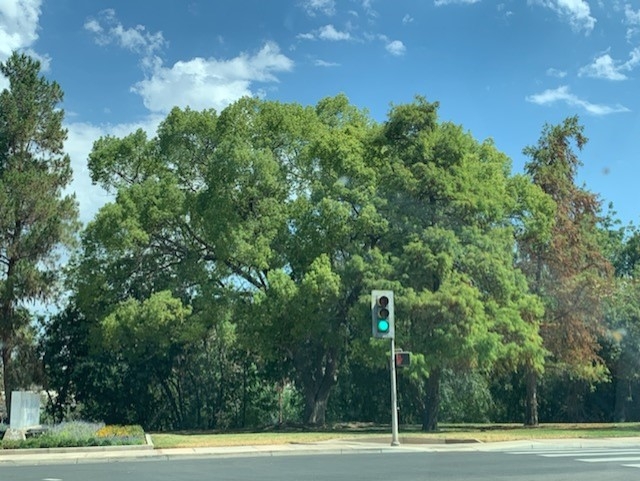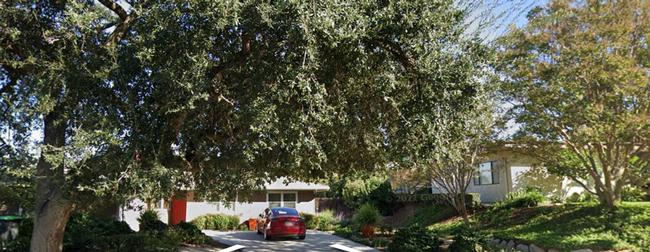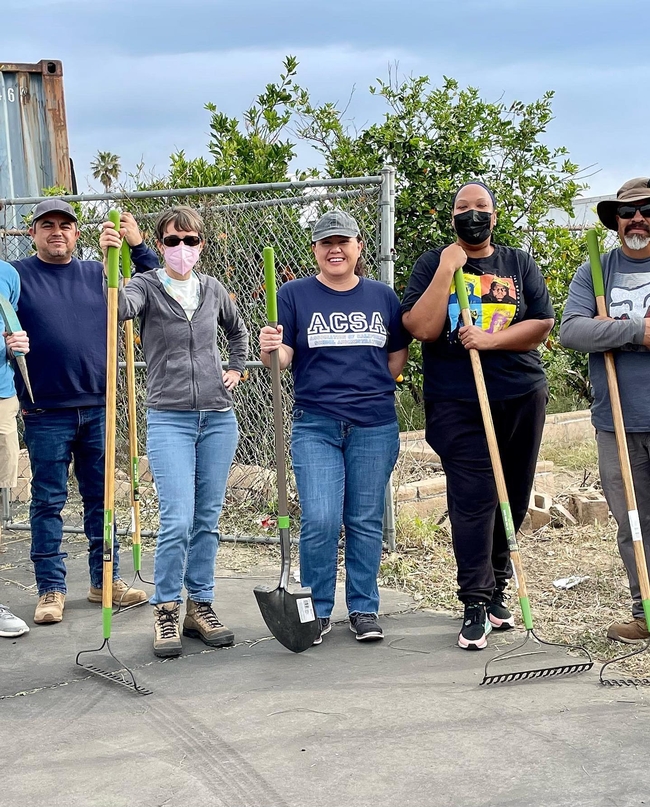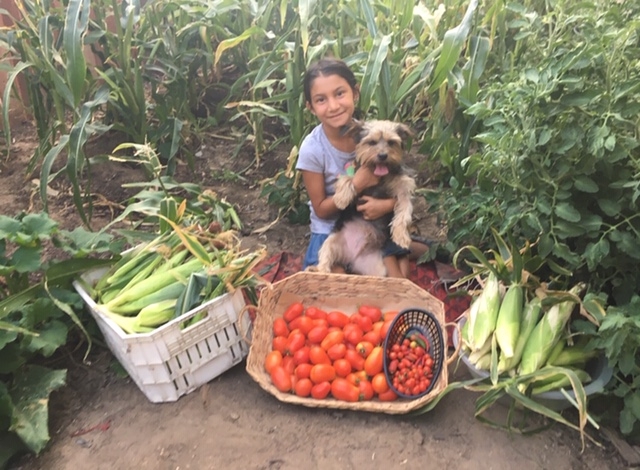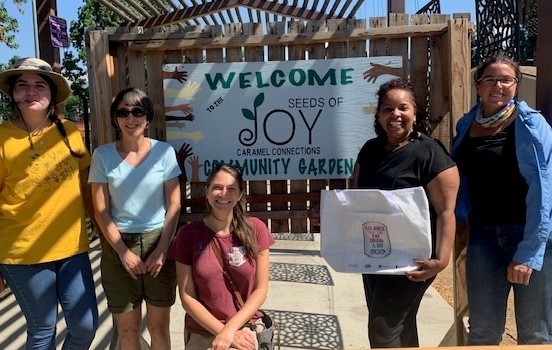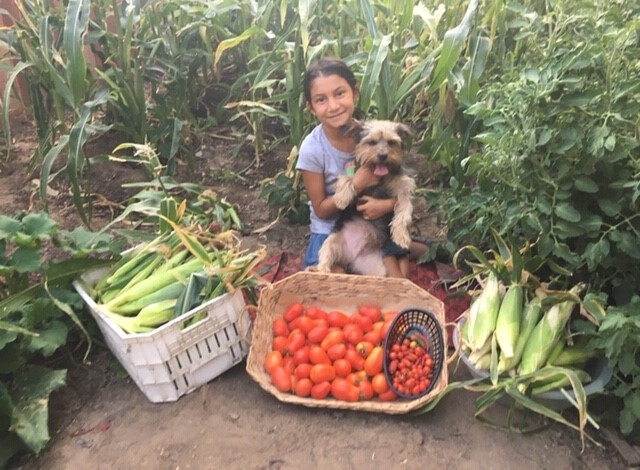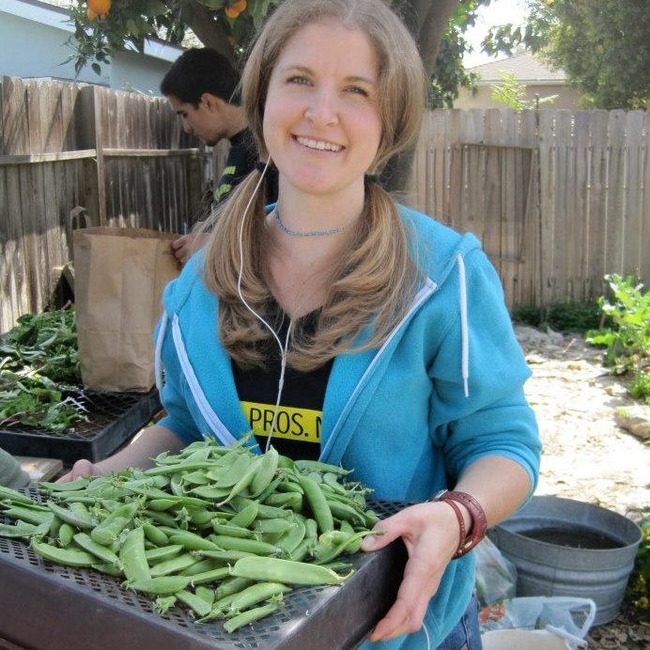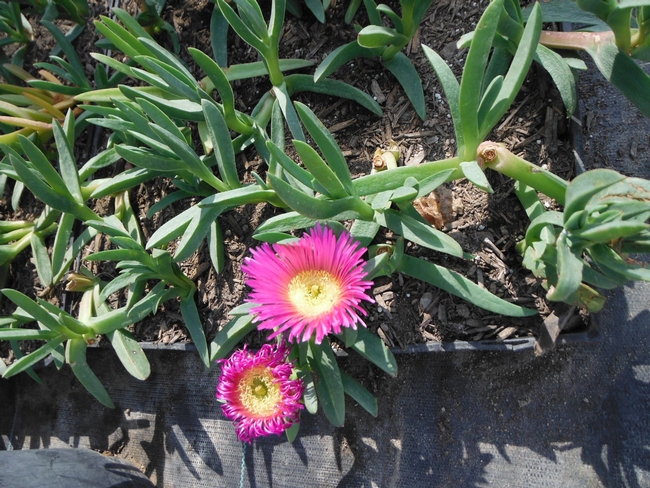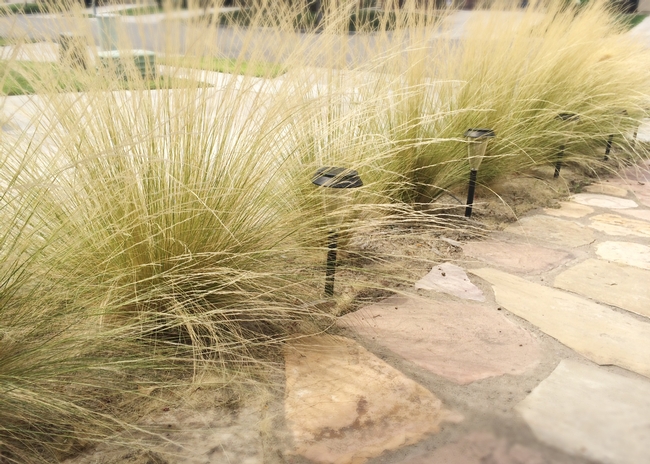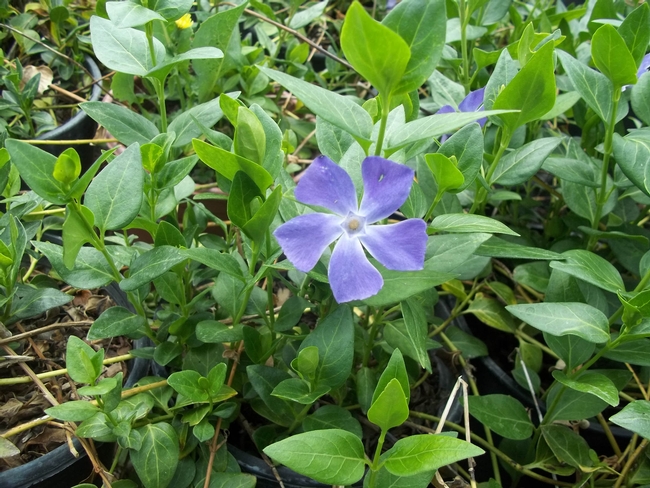Posts Tagged: plants
Climate change resources for Horticulturists, Government Officials, and UCCE Master Gardeners
Climate Change Resources for Horticulturists and UCCE Master Gardeners
Updated by Janet Hartin jshartin@ucanr.edu 8/17/2022
University of California UC ANR Green Blog (Climate Change and Other Topics) https://ucanr.edu/blogs/Green/index.cfm?tagname=climate%20change (full index)
Examples:
- Save Trees First: Tips to Keep Them Alive Under Drought https://ucanr.edu/b/~CdD
- Landscaping with Fire Exposure in Mind: https://ucanr.edu/b/~G4D
- Cities in California Inland Areas Must Make Street Tree Changes to adapt to Future Climate https://ucanr.edu/b/~oF7
UC Climate Change Videos
Drought, Climate Change and California Water Management Ted Grantham, UC Cooperative Extension specialist (23 minutes) https://youtu.be/dlimj75Wn9Q
Climate Variability and Change: Trends and Impacts on CA Agriculture Tapan Pathak, UC Cooperative Extension specialist (24 minutes) https://youtu.be/bIHI0yqqQJc
California Institute for Water Resources (links to blogs, talks, podcasts, water experts, etc.) https://ciwr.ucanr.edu/California_Drought_Expertise/
UC ANR Wildfire Resources (publications, videos, etc.) https://ucanr.edu/News/For_the_media/Press_kits/Wildfire/ (main website)
UC ANR Fire Resources and Information https://ucanr.edu/sites/fire/ (main website)
Preparing Home Landscaping https://ucanr.edu/sites/fire/Prepare/Landscaping/
UC ANR Free Publications https://anrcatalog.ucanr.edu/ (main website)
Keeping Plants Alive Under Drought and Water Restrictions (English version) https://anrcatalog.ucanr.edu/pdf/8553.pdf
(Spanish version) https://anrcatalog.ucanr.edu/pdf/8628.pdf
Use of Graywater in Urban Landscapes https://anrcatalog.ucanr.edu/pdf/8536.pdf
Sustainable Landscaping in California https://anrcatalog.ucanr.edu/pdf/8504.pdf
Other UC (Non-ANR) scientists
Daniel Swain (UCLA): website: https://weatherwest.com/ twitter: @Weather_West
Non-UC Climate Change Resources
Urban Forests and Climate Change. Urban forests play an important role in climate change mitigation and adaptation. Active stewardship of a community's forestry assets can strengthen local resilience to climate change while creating more sustainable and desirable places to live. https://www.fs.usda.gov/ccrc/topics/urban-forests
Examining the Viability of Planting Trees to Mitigate Climate Change (plausible at the forest level) https://climate.nasa.gov/news/2927/examining-the-viability-of-planting-trees-to-help-mitigate-climate-change/
Reports and other information resources coordinated under the auspices of the United Nations and produced through the collaboration of thousands of international scientists to provide a clear and up to date view of the current state of scientific knowledge relevant to climate change. United Nations Climate Action
Scientific reports, programs, action movements and events related to climate change. National Center for Atmospheric Research (National Science Foundation)
Find useful reports, program information and other documents resulting from federally funded research and development into the behavior of the atmosphere and related physical, biological and social systems. Search and find climate data from prehistory through to an hour ago in the world's largest climate data archive. (Formerly the "Climatic Data Center") National Centers for Environmental Information (NOAA)
Think tank providing information, analysis, policy and solution development for addressing climate change and energy issues (formerly known as the: "Pew Center on Global Climate Change"). Center for Climate & Energy Solutions (C2ES)
Mapping Resilience: A Blueprint for Thriving in the Face of Climate Disaster. The Climate Adaptation Knowledge Exchange (CAKE) was launched in July 2010 and is managed by EcoAdapt, a non-profit with a singular mission: to create a robust future in the face of climate change by bringing together diverse players to reshape planning and management in response to rapid climate change. https://www.cakex.org/documents/mapping-resilience-blueprint-thriving-face-climate-disaster
Cal-Adapt provides a way to explore peer-reviewed data that portrays how climate change might affect California at the state and local level. We make this data available through downloads, visualizations, and the Cal-Adapt API for your research, outreach, and adaptation planning needs. Cal-Adapt is a collaboration between state agency funding programs, university and private sector researchers https://cal-adapt.org/
Find reports, maps, data and other resources produced through a confederation of the research arms of 13 Federal departments and agencies that carry out research and develop and maintain capabilities that support the Nation's response to global change. Global Change (U.S. Global Change Research Program)
The Pacific Institute is a global water think tank that combines science-based thought leadership with active outreach to influence local, national, and international efforts to develop sustainable water policies. https://pacinst.org/our-approach/
Making equity real in climate adaptation and community resilience policies and programs: a guidebook. https://greenlining.org/publications/2019/making-equity-real-in-climate-adaption-and-community-resilience-policies-and-programs-a-guidebook/
Quarterly CA Climate Updates and CA Drought Monitor Maps (updated each Thursday) https://www.drought.gov/documents/quarterly-climate-impacts-and-outlook-western-region-june-2022
Drought Resources for Keeping Trees Alive
University of California Cooperative Extension Drought Resources To Keep Your Plants Alive
"Trees Come First Under Drought and Water Restrictions"
Keeping Plants Alive Under Drought and Water Restrictions (English) https://anrcatalog.ucanr.edu/pdf/8553.pdf
Keeping Plants Alive Under Drought and Water Restrictions (Spanish) https://anrcatalog.ucanr.edu/pdf/8628.pdf
Prioritizing Trees During Drought and Water Restrictions (5 minute Youtube)
https://www.youtube.com/watch?v=CTKLlJgdLVk
Tips to Keep Your Landscape Trees Alive Under Drought https://ucanr.edu/b/~IjC
Landscape Tree Irrigation to Maximize Tree Health, Benefits, and Beauty https://ucanr.edu/b/~YjA
Landscape Tree Irrigation 101 https://ucanr.edu/b/~UjA
Top 10 Ways to Conserve Water in Your Landscape and Garden https://ucanr.edu/b/~tTD
Asphalt and Synthetic Turf are Superheating our Cities (in Desert Sun newspaper) https://www.desertsun.com/story/opinion/contributors/valley-voice/2022/04/09/coachella-valleys-asphalt-synthetic-lawn-heat-islands-reach-170/9515857002/
Use of Graywater in Urban Landscapes in California https://anrcatalog.ucanr.edu/pdf/8536.pdf
Need More Help? Speak to a UC Cooperative Extension Master Gardener in Your County of Residence.
Find email and phone helplines here: Find a UC Master Gardener Program - UC Master Gardener Program (ucanr.edu)Benefits of Plants to People, Communities, and Urban Urban Ecosystems: Part 1
Benefits of Plants to People, Communities and Urban Ecosystems: Part 1:
The link between horticulture and health and well-being and to urban ecosystems has been scientifically documented for centuries. In 1812, psychiatrist, professor, and Declaration of Independence signer Dr. Benjamin Rush reported in his book “Medical Inquiries and Observations, Upon the Diseases of the Mind” (Rush 1812) that patients “digging in the dirt”
fared better than their non-gardener counterparts. Since then, hundreds of scientific studies have been published documenting benefits of active (e.g. gardening/landscaping) and passive (e.g. viewing nature through a window, taking a walk in a park) interactions between people and plants and the value of plants in urban ecosystems.Benefits related to cognitive functioning, societal and community health, and mental health are summarized below. Ecosystem and physical health benefits from interacting with nature will be discussed in next month's blog.
Improved Cognitive Functioning
Several studies link participation in gardening activities to enhanced cognitive functioning (Bratman et al. 2012; Dadvand et al. 2015; Kuo et al. 2021; Ohly et al. 2016; Park et al. 2019; Stevenson et al. 2018; Wells 2000. Research conducted by Kuo and Sullivan (2001) and Mayer et al. (2009) found that exposure to nature in urban settings can enhance attention span, working memory, and concentration. Both youth and adults who participate in greening and gardening projects were also found to have higher cognitive functioning in the areas of short and long term memory, focus and concentration (Dadvand et al. 2015; Markevych et al. 2019; Matsuoka 2010; Meuwese et al. 2021; Park et al. 2019; Stevenson et al. 2018) and reduced symptoms of ADHD (Faber Taylor and Kuo (2011).
Other studies summarized in a literature review (Williams and Dixon 2013) found that kindergarten and middle school students who participated in school gardening activities linked to classroom learning in biology, nutrition, mathematics, and other subjects earned higher grades and attained greater academic achievement than non-participants. A recent study linked high tree canopy coverage on school grounds with higher achievement scores in math and reading in middle school students across a wide range of socioeconomic and ethnic backgrounds (Kuo et al. 2021). The experiential (hands-on) learning elements of school gardens can also bridge the gap between traditional and non-traditional learners due to its multi-sensory nature (Kolb and Kolb 2005). School gardens play an especially important academic role among elementary-aged youth from low-wealth inner city communities exposed to outdoor experiential learning that was previously lacking (Dyg et al. 2020; Kuo et al. 2021; Ray et al. 2016; Williams et al. 2013). However, Hoover et al. (2021) found that successful, sustainable school gardens require strong administrative and district support in addition to enthusiasm and support from parents and teachers.
Enhancement of Societal and Community Health
Urban greening projects that remediate vacant land, landscape streets and neighborhoods, create community gardens, and improve the health of wetlands and undeveloped natural environments can build community cohesiveness, neighborhood bonding, and mutual community pride (Diamant and Waterhouse 2010; Draper 2010; Glover et al. 2005; Hartwig and Mason 2016; Kuo and Sullivan 2001; Moyer et al. 2019; Neo and Chua 2017; Saldivar-Tanaka and Krasny 2004). With blighted uncared-for vacant lots comprising nearly 15% of total land area of U.S. cities (Branas et al. 2018) these opportunities are substantial. Results also indicate that gardening and urban greening projects unite people from different cultural and ethnic backgrounds who enjoy growing and sharing produce from their native regions (Agustina and Beilin 2012; Baker 2004; Cruz-Piedrahita et al. 2020; Dyg et al. 2016; Hartwig and Mason 2016; Teig 2009). Building a sense of community through social engagement, celebrations, and communal meals has also been found to benefit both gardeners and non-gardener participants (Ober et al. 2008).
Well-designed and maintained urban green spaces not only bring people together, but can reduce crime, gun violence and enhance the safety and cohesiveness of urban neighborhoods, as summarized in several literature reviews (Bogar and Byer 2016: Mancus and Campbell 2018; Shepley et al. 2019). Some of the strongest links reported in the literature involve crime reduction in vegetated and well maintained urban neighborhoods and walkways (Branas et al. 2018; Demotto 2006; Garvin et al. 2013; Locke et al. 2017) and a reduction in gun violence in neighborhoods with green spaces including trees (Branas et al. 2018; Kondo 2017; Schertz et al. 2021; Wolfe et al. 2012). One study found that community-based greening projects that vegetated vacant lots was an effective strategy to improve neighborhood safety, resulting in a nearly 40% decrease in violent crime (Heinze et al. 2018). It should be noted that other researchers (Groff and McCord 2012) found a higher incidence of opportunistic crime in high tree canopy covered areas, perhaps due to concealed illegal activities. Another study found that actively participating in community greening projects from design through implementation and maintenance can result in a sense of accomplishment and satisfaction (Murphy-Dunning 2009). Neighbors caring for urban green spaces together also tend to spend more time conversing and building important social relationships than do non-participants (Peters et al. 2010).
Improved Mental Health
Multiple literature reviews link interactions with nature to improved mental health in both youth and adults (Bowler et al. 2010; Clatworthy et al. 2013; Coventry et al. 2021; Cruz-Piedrahita et. al. 2020; De Vries et al. 2003; Tillmann et al. 2018) in studies conducted in parks, gardens, urban green spaces, and even shopping malls. The restorative impact of simply viewing plants has also been widely studied. Walking through a park and even viewing a natural scene through a window can lead to a sense of well-being, restfulness, reflection, and reduced mental fatigue (Shanahan et al. 2019). More recently, Dzhambov et al. (2020) found lower rates of depression in students homebound for long periods of time during the COVID-19 pandemic with views of plants (indoors and out) compared to students who lacked plant interactions. Bowler's (2010) literature review also highlighted strong associations for self-reported positive emotions and lower levels of anger and sadness in natural settings compared to non-natural settings. Interactions with nature can also reduce symptoms of depression and anxiety (Beyer et al. 2014; Gonzalez et al. 2010; Lee and Maheswaran 2011; Van den Berg and Custers 2011; Wilson and Christensen (2011).
Thompson Coon et al. (2011) reported that exercising outdoors in natural settings led to greater feelings of positivity and revitalization, less tension, anger, and depression compared to the same amount of exercise indoors. Other studies link gardening to feelings of peace and contentment (Meuwese et al. 2021; Shanahan et al. 2015; Shanahan et al. 2019). MacKerron and Mourato (2013) reported that individuals who interact with nature are often happier than those lacking this interaction and Ambrose et al. (2020) reported that home gardeners growing food crops experienced particularly high levels of happiness and meaningfulness. Bakolis et al. (2018) linked two elements of mental well-being (optimism and energy) to interactions with nature while Van den Berg and Clusters (2011) and Wood et al. (2016) found a link between engagement with nature and a reduction in stress. While White et al. (2019) determined that these benefits are maximized when individuals spend 120 minutes a week or more interacting with nature, shorter periods of exposure are also beneficial (Shanahan et al. 2016; Shanahan et al. 2019; White et al. 2019).
Other studies reported a link between growing food and a deepened sense of purpose (Tzoulas 2007; Wiesinger 2006). Digging in the soil can be a welcome distraction from busy lives laden with deadlines, traffic jams, and other everyday stressors. Focusing on the needs of plants, whether it be watering, fertilizing, harvesting or other tasks, can prove pleasantly distracting, providing time for reflection and even problem resolution (Capaldi et al. 2015; Meuwese et al. 2021; Stevenson et al. 2018). Several research papers report important positive roles that plants play related to mental health as impacts of climate change increase (Cryder et al. 2006; Dillman-Hasso et al. 2021; Doherty 2018; Fernandez et al. 2015) related to posttraumatic stress disorder (PTSD), major depressive disorder, stress, anxiety and others.
Literature Cited
Agustina I and Beilin R. 2012. Community gardens: Space for interactions and adaptations, Procedia - Social and Behavioral Sciences. 36:439-448. https://doi.org/10.1016/j.sbspro.2012.03.048
Ambrose G, Das K, Fan Y, Ramaswami A. 2020. Is gardening associated with greater happiness of urban residents? A multi-activity, dynamic assessment in the Twin-Cities region, USA, Landscape and Urban Planning,198(2020). https://doi.org/10.1016/j.landurbplan.2020.103776
Baker LE. 2004. Tending cultural landscapes and food citizenship in Toronto's community gardens. Geographical Review, 94(3):305-325. https://doi.org/10.1111/j.1931-0846.2004.tb00175.x
Bakolis I, Hammoud, R, Smythe, M, et al. 2018. Using Smartphone Technologies to Investigate the Impact of Nature on Mental Well-Being in Real Time, BioScience. 68:134–145, https://doi.org/10.1093/biosci/bix149
Beyer KM, Kaltenbach A, Szabo A, et al. 2014. Exposure to neighborhood green space and mental health: evidence from the survey of the health of Wisconsin. Int. J. Environ. Res. Public Health. 11:3453-3472. https://doi.org:10.3390/ijerph110303453
Bogar S. and Beyer K. 2016. Green space, violence, and crime: a systematic review. Trauma, Violence, & Abuse 17(2)160-171. Accessed Sept. 28, 2021 from: http://journals.sagepub.com.proxyau.wrlc.org/doi/pdf/10.1177/1524838015576412
Bowler DE, Buyung-Ali, L, Knight TM, Pullin AS. 2010. Urban greening to cool towns and cities, A systematic review of the empirical evidence. Landscape and Urban Planning, 97(3):147–155. https://doi.org/10.1186/1471-2458-10-456
Branas C, South E, Kondo M, Hohl B, Bourgois P, Wiebe D, MacDonald J. 2018. Citywide cluster randomized trial to restore blighted vacant land and its effects on violence, crime, and fear. Proceedings of the National Academy of Sciences of the United States of America. http://www.pnas.org/content/early/2018/02/20/1718503115
Bratman GN, Hamilton JP, Daily GC. 2012. The impacts of nature experience on human cognitive function and mental health. Ann. N. Y. Acad. Sci. 1249:118–136. https://doi.org:10.1111/j.1749-6632.2011.06400.x
Capaldi CA, Passmore H, Nisbet EK, Zelenski JM, Dopko RL. 2015. Flourishing in nature: A review of the benefits of connecting with nature and its application as a wellbeing intervention. International Journal of Wellbeing, 5(4):1-16. https://doi.org:10.5502/ijw.v5i4.1
Clatworthy J, Hinds J, Camic P. 2013. Gardening as a mental health intervention: a review. Mental Health Review. 18 (4):214-225. https://doi.org:10.1108/MHRJ-02-2013-0007
Coventry PA, Jennifer VE, Brown J, et al. 2021. Nature-based outdoor activities for mental and physical health: Systematic review and meta-analysis. Popul Health.1;16:100934. https://doi.org/10.1016/j.ssmph.2021.100934
Cruz-Piedrahita C, Howe C, de Nazelle A. 2020. Public health benefits from urban horticulture in the global north: A scoping review and framework, Global Transitions 2:246-256 https://doi.org/10.1016/j.glt.2020.10.001
Cryder CH, Kilmer RP, Tedeschi RG, Calhoun LG. 2006. An exploratory study of posttraumatic growth in children following a natural disaster. Am J Orthopsychiatry 76(1):65–69. https://doi.org:doi:10.1037/0002-9432.76.1.65
Dadvand P, Nieuwenhuijsen, MJ, Esnaola M, et al. 2015. Green spaces and cognitive development in primary schoolchildren. Proceedings of the National Academy of Sciences of the United States of America, 112(26):7937–7942. https://doi.org/10.1073/pnas.1503402112
Demotto N, and Davies CP. 2006. A GIS analysis of the relationship between criminal offenses and parks in Kansas City, Kansas. Cartogr. Geogr. Inf. Sci.33:141-157. https://doi.org/10.1559/152304006777681715
De Vries S, Verheij RA, Groenewegen PP, Spreeuwenberg P. 2003. Natural environments-healthy environments? An exploratory analysis of the relationship between greenspace and health. Environment and planning. 35(10):1717–1731. https://doi.org/10.1068/a35111
Diamant E and Waterhouse A. 2010. Gardening and belonging: reflections on how social and therapeutic horticulture may facilitate health, wellbeing and inclusion. Br J Occup Ther.73:84-88. https:doi.org: https://doi.org/10.4276/030802210X12658062793924
Dillman-Hasso N. 2021. The nature buffer: the missing link in climate change and mental health research. J Environ Stud Sci. https://doi.org/10.1007/s13412-021-00669-2
Doherty TJ. 2018. Individual impacts and resilience. In: Clayton S, Manning C (eds) Psychology and Climate Change. Academic Press, pp 245–266. https://doi.org/10.1016/B978-0-12-813130-5.00010-2
Draper C and Freedman D. 2010. Review and Analysis of the Benefits, Purposes, and Motivations Associated with Community Gardening in the United States, Journal of Community Practice. 8(4):458-492. https://doi:10.1080/10705422.2010.519682
Dzhambov AM, Lercher P, Browning MH, et al. 2020. Does greenery experienced indoors and outdoors provide an escape and support mental health during the COVID-19 quarantine? Environmental Research, 110420. https://doi.org/10.1016/j.envres.2020.110420
Dyg P, Christensen S, Peterson C. 2020. Community gardens and wellbeing amongst vulnerable populations: a thematic review, Health Promotion International, Volume 35, Issue 4, August 2020, Pages 790–803, https://doi.org/10.1093/heapro/daz067
Faber Taylor A and Kuo FE. 2011. Could exposure to everyday green spaces help treat ADHD? Evidence from children's play settings. Applied Psychology: Health and Well-Being, 3: 281-303. https://doi.org/10.1111/j.1758-0854.2011.01052.x
Fernandez A, Black J, Jones M, Wilson L, Salvador-Carulla L, Astell-Burt T, Black D. 2015. Flooding and mental health: a systematic mapping review. PLoS One https://doi.org:10(4):e0119929
Garvin EC, Cannuscio CC, Branas CC. 2013. Greening vacant lots to reduce violent crime: A randomised controlled trial. Inj Prev. 19:198–203. https://doi.org:10.1136/injuryprev-2012-040439
Glover TD, Shinew KJ, Parry DC. 2005. Association, sociability, and civic culture: the democratic effect of community gardening. Leis Sci. 2005;27(1):75–92. https://doi.org:10.1080/01490400590886060
Gonzalez MT, Hartig T, Patil GG, Martinsen EW, Kirkevold M. 2010. Therapeutic horticulture in clinical depression: a prospective study of active components. J Adv Nurs. 66:2002-2013. https://doi.org:10.1891/1541-6577.23.4.312
Groff, E and McCord ES. 2012. The role of neighborhood parks as crime generators. Secur. J. 25:1–24, https://doi.org:10.1057/SJ.2011.1
Hartwig, KA and Mason M. 2016. Gardens for refugee and immigrant communities as a means of health promotion. J. Community Health, 41 (6):1153-1159. https://doi.org/10.1007/s10900-016-0195-5
Heinze JE, Krusky-Morey A, Vagi KJ, Reischl TM Franzen S, Pruett NK, Cunningham RM, Zimmerman MA. 2018. Busy streets theory: the effects of community-engaged greening on violence. American journal of community psychology, 62(1-2):101–109. https://doi.org/10.1002/ajcp.12270
Hoover, Amy, Vandyousefi Sarvenaz, Martin Bonnie, et al. 2021. Barriers, Strategies, and Resources to Thriving School Gardens, J Nutr Educ Behav. 53(7):591-601. https://doi.org/10.1016.j.jneb.2021.02.011
Kolb DA and Kolb AY. 2005. Learning styles and learning spaces: Enhancing experiential learning in higher education, Academy of Management Learning and Education, 4(2):193-212. Accessed Sept. 16 2021: http://www.jstor.org/stable/40214287.
Kondo MC, South EC, Branas CC, Richmond TS, Wiebe D.J. 2017. The association between urban tree cover and gun assault: a case-control and case-crossover study. American Journal of Epidemiology 186(3):289-296. https://doi.org:10.1093/aje/kwx096
Kuo M, Klein SE, Browning MH, Zaplatosch J. 2021. Greening for academic achievement: Prioritizing what to plant and where, Landscape and Urban planning, 206(2021). https://doi.org/10.1016/j.landurbplan.2020.103962
Kuo F.E.; Sullivan W.C. 2001. Environment and Crime in the Inner City—Does Vegetation Reduce Crime? Environ. Behav. 33(343). https://doi.org:10.1177/0013916501333002
Lee, ACK and Maheswaran, R. 2011. The health benefits of urban green spaces: a review of the evidence. Journal of Public Health, 33(2), 212-222. https://doi.org/10.1093/pubmed/fdq068
Locke DH, Han S, Kondo MC, Murphy-Dunning C, Cox M. 2017. Did community greening reduce crime? Evidence from New Haven, CT, 1996–2007. Landsc. Urban Plan. 2017;161:72–79. https://doi.org:10.1016/j.landurbplan.2017.01.006
MacKerron G and Mourato S. 2013. Happiness is greater in natural environments. Global Environmental Change. 23(5):992-1000. https://doi.org/10.1016/j.gloenvcha.2013.03.010
Mancus GC and Campbell J. 2018. Integrative review of the intersection of green space and neighborhood violence. J. Nurs. Scholarsh. 50:117–125. https://doi.org:10.1111/jnu.12365
Markevych, I. Feng, X. Astell-Burt T. Standl M. Sugiri D. Schikowski, et al. 2019. Residential and school greenspace and academic performance: Evidence from the GINIplus and LISA longitudinal studies of German adolescents. Environ. Pollut. 245:71-76. https://doi.org/10.1016/j.envpol.2018.10.053
Matsuoka RH. 2010. Student performance and high school landscapes: Examining the links. Landsc. Urban Plan. 97:273-282. https://doi.org/10.1016/j.landurbplan.2010.06.011
Mayer FS, Frantz CM, Bruehlman-Senecal E, Dolliver K. 2009. Why Is Nature Beneficial? The Role of Connectedness to Nature. Environment and Behavior.41(5):607-643. https://doi.org:10.1177/0013916508319745
Meuwese D, Maas J, Krabbendam L, Dijkstra K. 2021. Viewing Nature Lets Your Mind Run Free: Three Experiments about the Influence of Viewing a Nature Video on Cognitive Coping with Psychological Distress. Int J Environ Res Public Health. 22;18(16):8842. https://doi.org:10.3390/ijerph18168842
Moyer R, MacDonald JM, Ridgeway G, Branas CC. 2019. Effect of remediating blighted vacant land on shootings: a citywide cluster randomized trial. Am. J. Public Health.109:140–144. https://doi.org/10.2105/AJPH.2018.304752
Neo H and Chua CY. 2017. Beyond inclusion and exclusion: community gardens as spaces of responsibility. Ann. Am. Assoc. Geogr. 107(3):666-681. https://doi.org:10.1080/24694452.2016.1261687
Ober J, et al. 2008. Growing vegetables and values: benefits of neighborhood-based community gardens for youth development and nutrition, Journal of Hunger & Environmental Nutrition 3(4):418-439, https://doi.org:10.1080/19320240802529169
Ohly H, White MP, Wheeler BW, et al. 2016. Attention restoration theory: A systematic review of the attention restoration potential of exposure to natural environments. Journal of Toxicology and Environmental Health, Part B, 19 (7):305-343, https://doi.org:10.1080/10937404.2016.1196155
Park, SA, Lee AY, Park H, Lee WL. 2019. Benefits of Gardening Activities for Cognitive Function According to Measurement of Brain Nerve Growth Factor Levels. International journal of environmental research and public health, 16(5):760. https://doi.org/10.3390/ijerph16050760
Ray R, Fisher DR, Fisher-Maltese C. 2016. School gardens in the city. Does environmental equity help close the achievement gap?. Du Bois Review: Social Science Research on Race, 13(2):379-395. Accessed Sept. 15, 2021 from: http://dx.doi.org/10.1017/S1742058X16000229
Rush B. Medical inquiries and observations upon diseases of the mind. Philadelphia: Kimber & Richardson; 1812. [Accessed August 28, 2010]. p. 226. Available at: http://deila.dickinson.edu/theirownwords/title/0034.htm
Saldivar-Tanaka L and Krasny ME. 2004. Culturing community development, neighborhood open space, and civic agriculture: the case of Latino community gardens in New York City. Agric. Hum. Val., 21 (4):399-412. https://doi.org/10.1023/B:AHUM.0000047207.57128.a5
Schertz KE, Saxon J, Cardenas-Iniguez C, et al. 2021. Neighborhood street activity and greenspace usage uniquely contribute to predicting crime. npj Urban Sustain.1(19). https://doi.org/10.1038/s42949-020-00005-7
Shanahan DF, Astell-Burt T, Barber EA, Brymer E, et al. 2019. Nature-based interventions for improving health and wellbeing: the purpose, the people and the outcomes. Sports (Basel)10;7(6):141. http://doi.org:10.3390/sports7060141
Shanahan DF, Fuller RA, Bush R, Lin BB, Gaston KJ. 2015. The health benefits of urban nature: how much do we need? BioScience 65(5):476–485. https://doi.org/10.1093/biosci/biv032
Shepley M, Sachs N, Sadatsafavi H, Fournier C, Peditto K. 2019. The impact of green space on violent crime in urban environments: An evidence synthesis. Int. J Environ Res Public Health. 2019;16(24):5119. https://doi.org:10.3390/ijerph16245119
Stevenson MP, Schilhab T, Bentsen P. 2018. Attention restoration theory II: A systematic review to clarify attention processes affected by exposure to natural environments Journal of Toxicology and Environmental Health, Part B, 21(4):227-268. https://doi.org:10.1080/10937404.2018.1505571
Teig E, Amulya J, Bardwell L, et al. 2009. Collective efficacy in Denver, Colorado: Strengthening neighborhoods and health through community gardens. Health & Place, 15(4): 1115-1122. https://doi.org/10.1016/j.healthplace.2009.06.003
Thompson Coon J, Boddy K, Stein R, et al. 2011. Does participating in physical activity in outdoor natural environments have a greater effect on physical and mental wellbeing than physical activity indoors? A systematic review. https://doi.org:10.1021/es102947t
Tillmann S, Tobin D, Avison W, Gilliland J. 2018. Mental health benefits of interactions with nature in children and teenagers: a systematic review. J Epidemiol. Community Health 72(10):958–966. https://doi.org:10.1136/jech-2018-210436
Tzoulas K, Korpela K, Venn S. 2007. Promoting ecosystem and human health in urban areas using green infrastructure: a literature review. Landsc. Urban Plan. 2007;81:167–178. https://doi.org/10.1016/j.landurbplan.2007.02.001
Van den Berg AE and Custers MH. 2011. Gardening promotes neuroendocrine and affective restoration from stress. J. Health Psychol.16:3–11https://doi.org/10.1177/1359105310365577
Wiesinger G, Neuhauser F, Putz M. 2006. Farming for health in Austrian Farms, horticultural therapy, animal-assisted therapy. In: Hassink J., Dijk M., editors. Farming for health: Green-Care farming across Europe and the United States of America. Springer; Dordrecht, The Netherlands, pp. 233–248. Wells, NM. 2000. At home with nature: Effects of “greenness” on children's cognitive functioning. Environ. Behav.32(6):775–795. https://doi.org:10.1177/00139160021972793
White MP, Alcock I, Grellier J. et al. 2019. Spending at least 120 minutes a week in nature is associated with good health and wellbeing. Sci Rep 9(7730). https://doi.org/10.1038/s41598-019-44097-3
Wilson JF and Christensen KM. 2011. The relationship between gardening and depression among individuals with disabilities. J. Ther. Hortic. 2011;21:28–41.
Williams DR, Dixon PS. 2013. Impact of Garden-Based Learning on Academic Outcomes in Schools: Synthesis of Research Between 1990 and 2010. Review of Educational Research. 2013;83(2):211-235. http://doi.org:10.3102/0034654313475824
Wolfe MK, Mennis J, Mennis J. 2012. Does vegetation encourage or suppress urban crime? Evidence from Philadelphia, PA. Landsc Urban Plan.108(2-4):112–122. https://doi.org:10.1016/j.landurplan.2012.08.006
Wood C.J., Pretty J., Griffin M. 2016. A case–control study of the health and well-being benefits of allotment gardening. J. Public Health. 38:336–e344. https://doi.org/10.1093/pubmed/fdv146
Wolch, J, Byrne, J Newell, J. 2014. Urban green space, public health, and environmental justice: The challenge of making cities `just green enough'. 125:234-244. https://doi.org10.1016/j.landurbplan.2014.01.017
Benefits of Horticulture and Human Interactions
“To forget how to dig the earth and to tend the soil is to forget ourselves.” Mohandas K. Gandhi, World leader, political ethicist, lawyer
“Everything that slows us down and forces patience, everything that sets us back into the slow circles of nature, is a help. Gardening is an instrument of grace. ” May Sarton, Poet “
"May our heart's garden of awakening bloom with hundreds of flowers.” Thich Nhat Hanh, global spiritual leader and activist “If you have a garden and a library, you have everything you need.” Marcus Tullius Cicero, Roman philosopher
"The importance of encouraging our children in outdoor work with living plants is now recognized. It benefits the health, broadens the education, and gives a valuable training in industry and thrift. The great garden movement is sweeping over all America, and our present problem is to direct it and make it most profitable to the children in our schools and homes. — Van Evrie Kilpatrick, 1918, in “The Child's Food Garden”
As the above quotes so beautifully proclaim, interacting with nature, whether passively (viewing plants) or actively (gardening, etc.) offers many positive benefits. In fact, the link between horticulture and health and well-being has been scientifically documented for centuries. In 1812, psychiatrist, professor, and Declaration of Independence signer Dr. Benjamin Rush reported that patients participating in gardening activities had better mental health outcomes than non-gardening counterparts.
Many additional papers were published throughout the 1800's documenting benefits of active participation in gardening. More recently, positive links between simply viewing plants through a window or even on a television, movie, or exercise apparatus screen have been reported in peer-review journals. A groundbreaking study in this area was published in 1984 by environmental psychologist Robert Ulrich (Ulrich, 1984) who compared post-operative patients recovering from gall bladder surgery who had views of landscape plants to recovering patients who had the same surgery in the same facility with views of a brick wall. Patients with landscape views had fewer surgical complications, shorter hospital stays, required fewer analgesics, had better moods, and even fewer derogatory remarks by medical staff in their daily records.
Since 1984, dozens of other studies have documented similar positive outcomes resulting from both passive and active engagement with nature and plants. These include improved physical, mental and emotional health; environmental benefits; and community and societal benefits. Recent literature reviews that summarize these findings include:
- An overview of 77 peer-reviewed journal articles (Howarth, et. al., 2020) identified 35 positive outcomes linking physical and mental health and well-being to active and passive horticultural interactions. doi: https://10.1136/bmjopen-2020-036923
-A meta-analysis (Soga, 2016) of 22 studies identified several positive mental health outcomes related to gardening including mood, group cohesiveness, cooperation, pride, well-being, and more. https://doi.org/10.1016/j.pmedr.2016.11.007 -
An overview of 45 peer-review studies (Shepley, et. al., 2019) identified links between properly designed and maintained urban green spaces and crime, gun violence, and the overall safety and cohesiveness of low-wealth urban neighborhoods. https://doi.org/10.3390/ijerph16245119
- A review of 120 papers (Crus-Piedrahita, et. al., 2020) reported public health benefits from urban horticulture activities in the global North. Thirty-two papers had a specific focus on social cohesion and/or social capital. https://doi:10.1016/j.glt.2020.10.001
-Alizadeh (2019) synthesized research regarding the environmental benefits of urban plants, highlighting their vital roles in combating climate change, cooling urban heat islands, providing habitat, removing air and water pollutants, enhancing soil health, and more. https://www.researchgate.net/deref/https%3A%2F%2Fdoi.org%2F10.1108%2FIJCCSM-10-2017-0179
Enjoy your garden! Enjoy a day in nature.
California Invasive Species Action Week – Let’s work together to be better, do better, and grow better.
Words like 'invasive plants' or 'weeds' often have a negative connotation for a good reason. Both words describe plants growing where they are not wanted or welcome. Plants that have a propensity to spread quickly result in habitat loss for native plants, insects, birds, and other animals. This is incredibly destructive to our natural environment and the landscape that Californians love to call our own.
Fast spreading invasive plants can quickly and dramatically change a plant community from a diverse one to a monoculture. When these plant communities shift, wildlife loses food, water and shelter resources and are forced to move out or perish.
Unfortunately, this description is not an over-dramatization. As Californians, we must communicate frankly about the impact of invasive plants in our environment. This is an important issue that can easily grow out of control. One of the biggest challenges with invasive plants is that they oftentimes have desirable features, like beautiful flowers or a spreading habit that quickly covers a barren patch in a home landscape.
Well-intentioned people have sold, purchased, propagated, and harvested plants that are known to be invasive. When done so knowingly, the gardener may use the excuse that they will watch the plant and not let it get out of control. Unfortunately, there is no way to monitor a plant that is distributed by wind, birds and other sources. It may be possible to monitor that your plant doesn't ‘escape' to the neighbor's garden but what about the seeds that blew off in the wind and established on a hillside two miles away?
Paying attention to signage and programs that identify invasive plants is an important part of caring for our environment. When questions about weeds and invasive plants arise, the UC Master Gardener Program is available locally to support good decisions and help us all be stewards of a healthy California.
Trained and certified volunteers utilize the vast network of information and expertise of the University of California to support gardeners and concerned citizens. You can reach your local county program online at mg.ucanr.edu/FindUs/.
It's Invasive Species Action Week – let's work together to be better, do better, and grow better.
California Invasive Plant Resources:
- Cal-IPC
- Plant-Right
- California Department Fish and Wildlife
- Weed Research & Information Center (UC ANR)
- UC Integrated Pest Managment
Spend your lunch learning about invasive species. Brought to you by UC Agriculture and Natural Resource and the California Invasive Plant Council, come hear from the experts about emerging tree pests, aquatic invasive species, and invasive weeds and fire.
Invasive Species Lunchtime Talks:
- Shot hole borers and other threats to California's trees (June 5, 12:10 - 1pm)
- Quagga mussels, nutria and other threats to California's water bodies (June 6, 12:10 - 1pm)
- Invasive plants and fire in California (June 7, 12:10 - 1pm)
Join from a PC, Mac, iPad, iPhone or Android device:
Please click this URL to join. https://ucanr.zoom.us/j/401190822
Or join by phone:
Dial(for higher quality, dial a number based on your current location):
US: +1 (646) 558-8656 or +1 (669)900-6833
Webinar ID: 401 190 822





